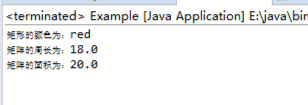Java实验报告
实验二 Java简单类与对象
一、 实验目的
(1) 掌握类的定义,熟悉属性、构造函数、方法的作用,掌握用类作为类型声明变量和方法返回值;
(2) 理解类和对象的区别,掌握构造函数的使用,熟悉通过对象名引用实例的方法和属性;
(3) 理解static修饰付对类、类成员变量及类方法的影响。
二、 实验内容
- 写一个名为Rectangle的类表示矩形。其属性包括宽width、高height和颜色color,width和height都是double型的,而color则是String类型的。要求该类具有:
(1) 使用构造函数完成各属性的初始赋值
(2) 使用get…()和set…()的形式完成属性的访问及修改
(3) 提供计算面积的getArea()方法和计算周长的getLength()方法
- 银行的账户记录Account有账户的唯一性标识(11个长度的字符和数字的组合),用户的姓名,开户日期,账户密码(六位的数字,可以用0开头),当前的余额。银行规定新开一个账户时,银行方面提供一个标识符、账户初始密码123456,客户提供姓名,开户时客户可以直接存入一笔初始账户金额,不提供时初始余额为0。定义该类,并要求该类提供如下方法:存款、取款、变更密码、可以分别查询账户的标识、姓名、开户日期、当前余额等信息。
三、 实验过程(请自己调整格式)
1 class Main 2 { 3 private double width,heigh; 4 private String color; 5 6 public Rectangle(double width,double heigh,String color) 7 { 8 this.setWidth(width); 9 this.setHeigh(heigh); 10 this.setColor(color); 11 } 12 public double getWidth() 13 { 14 return width; 15 } 16 public void setWidth(double width) 17 { 18 this.width=width; 19 } 20 public double getHeigh() 21 { 22 return heigh; 23 } 24 public void setHeigh(double heigh) 25 { 26 this.heigh=heigh; 27 } 28 public String getColor() 29 { 30 return color; 31 } 32 public void setColor(String color) 33 { 34 this.color=color; 35 } 36 public double getArea() 37 { 38 return this.width*this.heigh; 39 } 40 public double getLength() 41 { 42 return 2*this.width+2*this.heigh; 43 } 44 } 45 public class Rectangle 46 { 47 public static void main(String args[]) 48 { 49 Rectangle i = null; 50 i = new Rectangle(3,4,"red"); 51 System.out.println("矩形的颜色为:"+i.getColor()); 52 System.out.println("矩阵的周长为:"+i.getLength()); 53 System.out.println("矩阵的面积为:"+i.getArea()); 54 } 55 }

第二题我尽力了,只能写到这了,真心不会了
1 public class Account 2 { 3 private String id; 4 private String name; 5 private Date date; 6 private int password; 7 private int money; 8 9 public Account(String id, String name, int money) 10 { 11 super(); 12 this.id = id; 13 this.name = name; 14 this.money = money; 15 this.date = new Date(); 16 this.password = 123456; 17 } 18 19 public String getId() 20 { 21 return id; 22 } 23 24 public void setId(String id) 25 { 26 this.id = id; 27 } 28 29 public String getName() 30 { 31 return name; 32 } 33 34 public void setName(String name) 35 { 36 this.name = name; 37 } 38 39 public void jin(int num) 40 { 41 this.money = this.money+num; 42 } 43 44 public void chu(int num) 45 { 46 this.money = this.money-num; 47 } 48 49 public Date getDate() 50 { 51 return date; 52 } 53 54 public void setDate(Date date) 55 { 56 this.date = date; 57 } 58 59 public int getMoney() 60 { 61 return money; 62 } 63 64 public void setMoney(int money) 65 { 66 this.money = money; 67 } 68 69 public int getPassword() 70 { 71 return password; 72 } 73 74 public void setPassword(int password) 75 { 76 this.password = password; 77 }
四、 总结:
String 类两种实例方法区别:
(1)直接赋值:如String name = "lichen";。
(2)利用new开辟一个新的空间:如String name = new String("lichen");。
一个字符串就是一个String类的匿名对象。
匿名对象就是已经开辟了堆内存空间的并可以直接使用的对象
对象数组在使用前必须注意:
数组一定要先开辟空间;并且数组里面的每一个对象都是null值,所以在使用的时候数组中的每一个对象必须分别进行实例化。
包的概念:
包的概念,包是在使用多个类或接口时,为了避免名称重复而采用的一种措施。如果使用,直接在程序中加入package关键字即可。
import语句:
(1)定义,如果将几个类存放在不同的包中,则在使用类的时候就必须通过import语句导入。
(2)格式,import 包名称.子包名称.类名称;(手工导入所需要的类),import 包名称.子包名称.*;(由JVM自动加载所需要的类)。



)










)

)


——head和body标签)